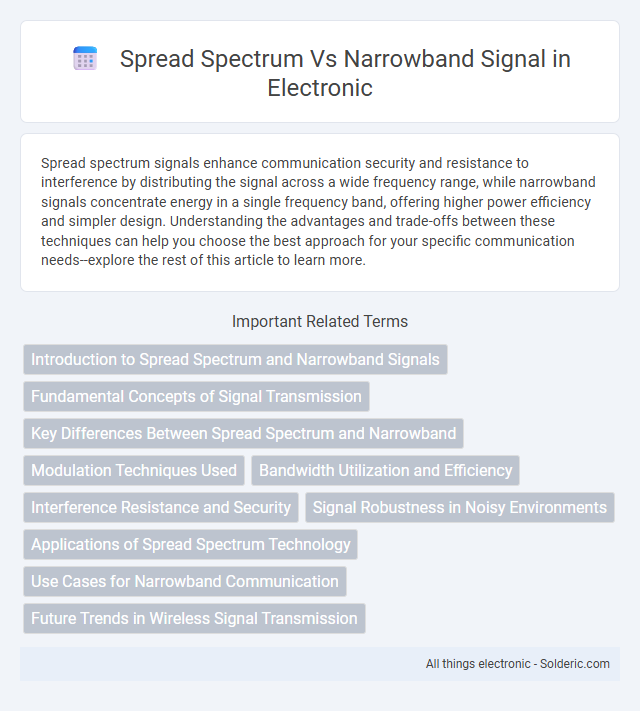Spread spectrum signals enhance communication security and resistance to interference by distributing the signal across a wide frequency range, while narrowband signals concentrate energy in a single frequency band, offering higher power efficiency and simpler design. Understanding the advantages and trade-offs between these techniques can help you choose the best approach for your specific communication needs--explore the rest of this article to learn more.
Comparison Table
| Feature | Spread Spectrum | Narrowband Signal |
|---|---|---|
| Bandwidth | Wideband, significantly larger than message bandwidth | Small, limited to message bandwidth |
| Interference Resistance | High, robust against jamming and noise | Low, more susceptible to interference |
| Security | High, difficult to intercept or detect | Low, easier to eavesdrop |
| Power Spectral Density | Low, spreads power over wide bandwidth | High, concentrated in narrow bandwidth |
| Complexity | Higher, requires spreading and de-spreading techniques | Lower, simpler modulation and demodulation |
| Applications | Military communications, GPS, CDMA cellular networks | Traditional radio, broadcast systems, basic data links |
| Multipath Resistance | Better performance in multipath environments | More affected by multipath fading |
Introduction to Spread Spectrum and Narrowband Signals
Spread spectrum signals use a wider bandwidth than the minimum required, spreading the signal energy over a broad range of frequencies to enhance security, resistance to interference, and multipath fading. Narrowband signals concentrate power within a narrow frequency band, offering higher spectral efficiency and simpler receiver design but are more susceptible to noise and interference. In wireless communication, spread spectrum techniques like Direct Sequence Spread Spectrum (DSSS) and Frequency Hopping Spread Spectrum (FHSS) provide robustness and privacy advantages compared to traditional narrowband transmission methods.
Fundamental Concepts of Signal Transmission
Spread spectrum transmits signals by spreading the signal energy across a wider frequency band than the minimum required, enhancing resistance to interference and preventing signal interception. Narrowband signals concentrate energy within a narrow frequency range, offering higher signal power density but increased vulnerability to noise and eavesdropping. Fundamental concepts highlight spread spectrum's use of techniques like Frequency Hopping Spread Spectrum (FHSS) and Direct Sequence Spread Spectrum (DSSS), improving security and robustness compared to the simpler, bandwidth-efficient narrowband transmission.
Key Differences Between Spread Spectrum and Narrowband
Spread spectrum signals distribute data over a wide frequency range, enhancing resistance to interference, jamming, and eavesdropping, while narrowband signals concentrate energy in a limited bandwidth, optimizing power efficiency and signal strength. Spread spectrum techniques include Frequency Hopping Spread Spectrum (FHSS) and Direct Sequence Spread Spectrum (DSSS), providing improved security and robustness for wireless communication. Narrowband systems offer superior signal-to-noise ratio (SNR) in stable environments but are more susceptible to narrowband interference compared to the resilient, broadband nature of spread spectrum signals.
Modulation Techniques Used
Spread spectrum signals primarily use modulation techniques such as Direct Sequence Spread Spectrum (DSSS) and Frequency Hopping Spread Spectrum (FHSS), which distribute the signal over a wide frequency range to enhance resistance to interference and eavesdropping. Narrowband signals employ conventional modulation methods like Amplitude Modulation (AM) and Frequency Modulation (FM), concentrating the signal power within a narrow frequency band for efficient bandwidth usage. DSSS modulates data by multiplying it with a high-rate pseudorandom noise sequence, while FHSS rapidly switches carrier frequencies, contrasting with the stable carrier signals used in narrowband modulation.
Bandwidth Utilization and Efficiency
Spread spectrum signals use a significantly wider bandwidth than narrowband signals, enhancing resistance to interference and eavesdropping but requiring more spectrum resources. Narrowband signals concentrate power in a smaller bandwidth, resulting in higher spectral efficiency and better energy utilization for a fixed data rate. The trade-off between bandwidth utilization and efficiency depends on application needs, with spread spectrum favoring robustness and narrowband optimizing transmission efficiency.
Interference Resistance and Security
Spread spectrum signals offer superior interference resistance by spreading the signal over a wide frequency band, making it less susceptible to narrowband interference and jamming. In contrast, narrowband signals concentrate power in a limited frequency range, making them more vulnerable to interference and signal disruption. Your communication security is enhanced with spread spectrum techniques due to their inherent resistance to eavesdropping and signal detection compared to narrowband signals.
Signal Robustness in Noisy Environments
Spread spectrum signals exhibit superior robustness in noisy environments due to their wide bandwidth, which allows them to resist interference and fading more effectively than narrowband signals. Narrowband signals, constrained to a smaller frequency range, are more susceptible to noise and intentional jamming, compromising data integrity. Your communication system can significantly benefit from spread spectrum techniques for enhanced noise immunity and reliable signal transmission.
Applications of Spread Spectrum Technology
Spread spectrum technology is widely used in military communications for secure and jam-resistant transmissions, as well as in commercial applications such as Wi-Fi, Bluetooth, and GPS systems for reliable data transfer in noisy environments. This technology contributes to enhanced privacy and signal robustness by spreading the signal over a wide frequency band, making it difficult to intercept or interfere with. If your application requires secure, interference-resistant communication, spread spectrum offers significant advantages over narrowband signals.
Use Cases for Narrowband Communication
Narrowband communication excels in applications requiring long-range transmission with low power consumption, such as in IoT devices, telemetry, and rural broadband. This signaling approach is ideal for sending small amounts of data over limited bandwidth, enhancing signal penetration in challenging environments like underground or dense urban areas. Your network benefits from narrowband's high spectral efficiency and reduced interference in scenarios where reliability is critical and data rates are minimal.
Future Trends in Wireless Signal Transmission
Future trends in wireless signal transmission emphasize the integration of spread spectrum techniques with advanced narrowband signaling to enhance spectrum efficiency and security. Emerging technologies leverage dynamic spectrum sharing and cognitive radio to optimize bandwidth use while maintaining robustness against interference and eavesdropping. Ultra-wideband (UWB) and 5G millimeter-wave systems illustrate the shift toward hybrid models that combine wide and narrowband features for improved data rates and connectivity in IoT and 6G networks.
Spread spectrum vs narrowband signal Infographic

 solderic.com
solderic.com